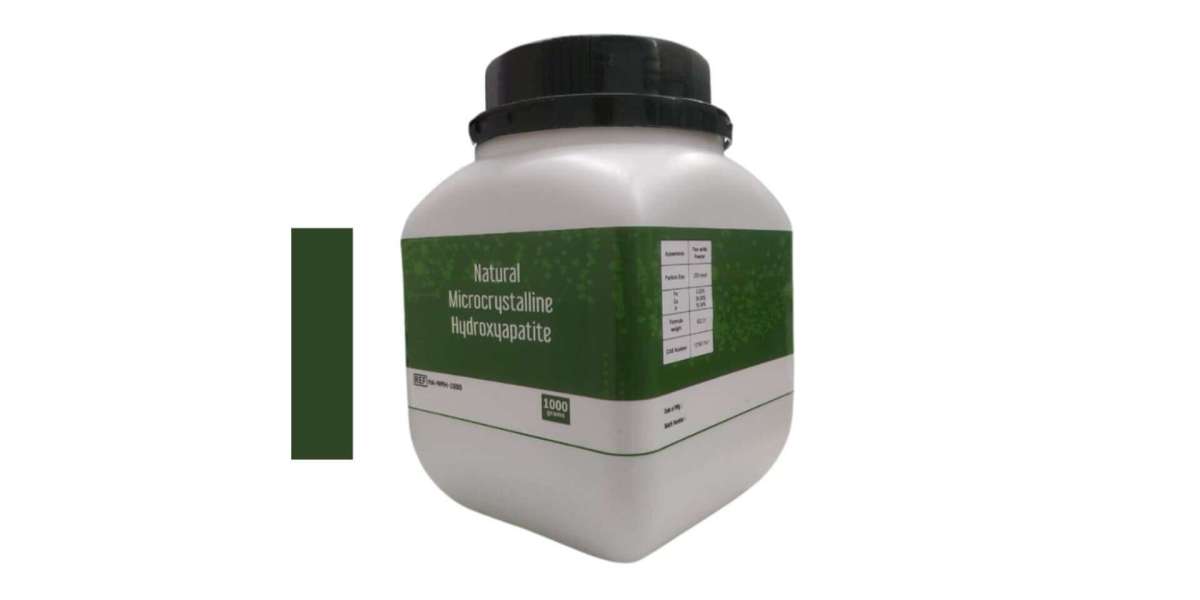Microcrystalline hydroxyapatite (MCHA) stands as a critical innovation in the fields of dentistry, orthopedics, nutrition, and regenerative medicine. As a highly bioavailable form of calcium and phosphate, this compound closely mimics the natural mineral composition of human bone and teeth. This article delves deep into the structure, properties, and applications of microcrystalline hydroxyapatite, highlighting why it has become indispensable in modern healthcare and industry.
Understanding the Structure of Microcrystalline Hydroxyapatite
What is Microcrystalline Hydroxyapatite?
Microcrystalline hydroxyapatite is a naturally derived or synthetically produced form of calcium phosphate with the chemical formula Ca₁₀(PO₄)₆(OH)₂. What sets MCHA apart is its crystalline microstructure, where the particle size is significantly reduced to the micrometer scale, improving surface area, reactivity, and biological compatibility.
Unlike traditional calcium supplements, MCHA contains collagen and trace minerals, when derived from bovine bone, offering a more complete nutrient profile that mimics bone matrix composition.
Atomic-Level Structure
At the atomic level, microcrystalline hydroxyapatite is characterized by:
Hexagonal crystal lattice – similar to that of natural bone.
Highly ordered phosphate and hydroxide groups, contributing to chemical stability.
Interspersed carbonate ions in biologically derived samples, enhancing bioactivity.
Micro-porous structure, allowing for better integration in biological tissues.
This structural similarity is crucial in its ability to bond directly with bone and dental tissue, a property called osteointegration.
Key Properties of Microcrystalline Hydroxyapatite
High Bioavailability – The calcium and phosphorus are in forms that the human body can absorb more easily.
Biocompatibility – Non-toxic and non-immunogenic, it integrates seamlessly with bodily tissues.
Osteoconductivity – Promotes bone growth by acting as a scaffold for new bone formation.
Non-Fluoride Remineralizer – An effective alternative to fluoride in toothpaste and dental treatments.
Slow Dissolution Rate – Ensures sustained mineral availability at the implantation site or ingestion point.
Major Applications of Microcrystalline Hydroxyapatite
1. Dental Care and Remineralization
MCHA is gaining widespread use in fluoride-free toothpaste as a powerful remineralizing agent. Unlike fluoride, which strengthens enamel indirectly, MCHA deposits directly into enamel micro-lesions, repairing and rebuilding tooth structure.
Benefits:
Reduces tooth sensitivity
Rebuilds enamel
Protects against caries
Gentle on the oral microbiome
Popular MCHA-based toothpastes include Apagard, Risewell, and Boka, with many premium brands now adopting this cutting-edge ingredient.
2. Orthopedic and Bone Regeneration
In orthopedic surgery, MCHA is used as a bone graft material, either on its own or in combination with other bioactive agents. Its ability to bond with bone tissue makes it ideal for:
Fracture repair
Bone defect filling
Joint reconstruction
Dental implants and socket preservation
MCHA promotes faster healing and natural bone regeneration, eliminating the need for synthetic fillers or metallic implants in many cases.
3. Nutritional Supplements
Microcrystalline hydroxyapatite derived from freeze-dried bovine bone is widely used as a calcium and phosphorus supplement. Unlike calcium carbonate or citrate, MCHA offers:
Better absorption due to structural similarity with human bone
Contains bone-building cofactors like collagen, magnesium, and trace minerals
Lower risk of arterial calcification compared to synthetic forms
Best for:
Postmenopausal women
Osteoporosis patients
Athletes under high skeletal stress
Seniors with declining bone mass
4. Biomedical Coatings and Implants
MCHA is often used to coat orthopedic and dental implants, such as titanium screws or plates, to enhance biocompatibility and improve integration. The coating:
Reduces inflammation and rejection
Encourages new bone to grow directly onto the implant
Increases the lifespan and success rate of prosthetics
5. Tissue Engineering and Regenerative Medicine
In cutting-edge regenerative research, MCHA is combined with biopolymers and stem cells to create scaffolds for bone and tissue growth. Its porous nature allows:
Nutrient flow and cell migration
Gradual resorption and replacement by natural bone
Reduced need for secondary surgeries
Applications include craniofacial reconstruction, maxillofacial surgery, and spinal repair.
Comparison with Other Forms of Calcium
| Feature | MCHA | Calcium Carbonate | Calcium Citrate |
|---|---|---|---|
| Absorption | High (mimics bone structure) | Moderate (requires stomach acid) | Moderate |
| Collagen & Cofactors | Yes | No | No |
| Bone Integration | Excellent | Poor | Poor |
| Risk of Arterial Calcification | Low | Moderate to High | Moderate |
| Use in Medical Devices | Yes | No | No |
Safety and Regulatory Status
MCHA is generally recognized as safe (GRAS) when used as a dietary supplement. For medical applications, it must comply with:
ISO 10993 for biocompatibility
FDA 510(k) clearance in the US
CDSCO regulations in India
It is important to source MCHA from GMP-certified manufacturers to ensure purity, especially when intended for implantable or ingestible applications.
Conclusion
Microcrystalline hydroxyapatite represents a scientific and clinical breakthrough in the treatment and management of bone and dental health. Its molecular similarity to human hard tissues, high bioavailability, and multi-functional properties make it superior to many conventional materials and supplements.
Whether used in orthopedic surgery, dental care, or daily nutrition, MCHA is setting new standards in biomaterial science and patient outcomes.



